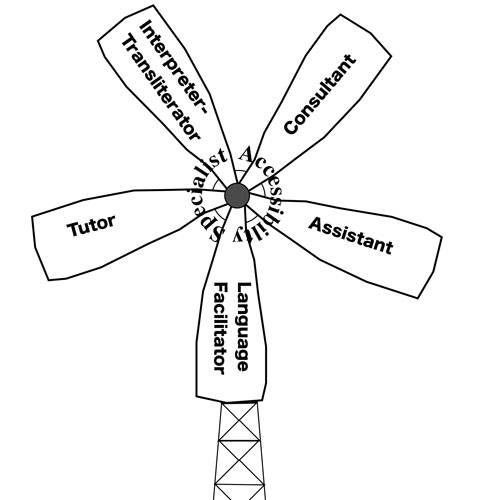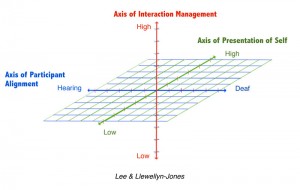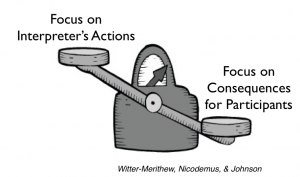Presentation Slides
Workshop Resources
"Exploring Emerging Paradigms" Resources
Educational Interpreting
Resources Related to Educational Interpreting
The National Association of Interpreters in Education

The National Association of Interpreters in Education (NAIE) is a professional organization for interpreters in educational settings established in 2016. http://naiedu.org/
 More than Meets the Eye: Revealing the Complexities of an Interpreted Education
More than Meets the Eye: Revealing the Complexities of an Interpreted Education
by Melissa B. Smith
http://gupress.gallaudet.edu/bookpage/MTMEbookpage.html
View the Ph.D. Dissertation this book is based on here.
Dr. Smith did a lecture at Gallaudet University on this topic.
You can see all of the presentations archived by Gallaudet University Regional Interpreter Education Center here.
Understanding the Impact of Interpretability in Mainstream Classrooms
This chapter by Betsy Winston lays out the limitations for rigid understandings of interpreting in classroom settings.
Winston, B. 2004. “Interpretability and Accessibility of Mainstream Classrooms,” In Educational Interpreting: How it Can Succeed. Gallaudet University Press. See the article.
Articles about Educational Interpreting
New Paradigms in the Interpreted Classroom: An article written by Doug Bowen-Bailey for the RID Views -(in press August 2014)
Perspectives from Gina Oliva
Dr. Oliva is the author of “Alone in the Mainstream” sharing her experience as an “only” going through mainstreamed settings – as well as some of her research about other deaf people who went through the mainstream in a similar way.
- Sign Language Interpreters in Mainstream Classrooms: Heartbroken and Gagged
An article on Street Leverage. Check it out. - K-12 Interpreters: A Call to Arms for Sign Language Interpreter Programs
An article on StreetLeverage. Check it out.
Determining a Student’s Readiness to Successfully Use Interpreting Services
This is an article from Cindy Huff, a teacher of the Deaf/Hard of Hearing, about a framework for assessing if students are at a developmental level appropriate for benefiting from an interpreted education.
Language Acquisition
The link below has a presentation in ASL about the Common Errors of Young Children Acquiring Sign Language, helpful information in seeing what is normal language development.
Providing Access: New Roles for Educational Interpreters
By Bernhardt E. Jones, Ed.D., C.S.C.
Originally published in the RID VIEWS
Conflicts can, and do, occur when it is unclear as to the interpreter’s role at any given time. This function changes during the day, especially in the lower grades. I am suggesting (as has Winston) that the title, “educational interpreter” is too narrow, and, in fact, this position is a multi-faceted responsibility. If this is true, how do we separate the roles? How do we define what it is that we do and when?
A year ago Winston (Views) did a fine job in delineating educational interpreting responsibilities into three roles: interpreting, tutoring and aiding. Since then, Winston has discussed the notion that consulting is also a role that educational interpreters play. Consulting may be a new area that you had not considered before. But, think about all the times you have given your input in the school situation. How many times have you talked to parents? How many times have you explained “deafness” to others in the school? to students? to administrators? to regular education teachers? You may find that this list is long. Go to the dictionary or, better, go to the Web and search the word, “consulting” or “consultant” and see what you find. Do you fit into this definition during part of the time you are working in the school setting?
The public school educational interpreter is viewed quite often as a paraprofessional and, in fact, is categorized that way in many states. However, we can make the case that, although the interpreter does perform many of the duties of the paraprofessional, she/he also performs a duty that is quite different and requires separate and distinct knowledge and skills: interpreting itself. Are we not, then, more than an educational interpreter? Might we be, to use a term that Winston has expressed, an “Accessibility Specialist?” I don’t want to confuse the issue with additional terms for us, but think about the variety of tasks you perform. Perhaps we are not “just the interpreter,”but we are more than the interpreter.
Take a look at your day (or week or month, if you would like). Make a list of all the duties you perform. Try to think of everything that happens in your job. What do you do? How long do you do it? Make the list as long and comprehensive as you can. You should have a collection of everything you do. You may be surprised to see that you do quite a bit for the school and the students (both deaf/hard of hearing and hearing).
The Windmill Model

Note: The graphic has been updated since the article was written so it does not perfectly correspond to the article.
The next step is to draw your own windmill and categorize the duties/tasks that you have listed. Interpreting will include anything you do in the role of an interpreter. Tutoring will include all the tasks you do within that context. Aiding is a large and varied area or responsibility. Think of all the things you do in an aiding capacity. As discussed above, consulting is also an important role of the educational interpreter.
Isn’t this appropriate? A windmill spins in the wind and must be flexible (accommodating) in order to operate effectively and efficiently. If one of the blades is broken or damaged, the windmill will not operate properly. Are we like that?
I suggest that we are. With this model we can delineate our roles. When we are able to do that, we can better understand why dilemmas cause conflict. Conflict arises when we are not sure on which blade to categorize our dilemma. We are better able to handle conflict if we know the rules by which to address the conflict. When conflict arises, we know where it fits and, therefore, we know how to respond (how to “spin” our windmill). [I guess it depends upon who is blowing on our windmill.] The blades of the windmill can be viewed as contexts. When we know the contexts, we know the rules. This is where the Code of Ethics has caused us concerns. When applied to the interpreting blade (role, context) of the model, it is easy to understand the importance of the Code and to adhere to its principles. When we apply those same criteria to the other blades (roles), it becomes cloudy and appears to conflict with the role. The problem is compounded if other professionals do not know our contexts and/or confuse our contexts (roles, blades). We then can apply the “educating others about our role(s)” principle of the Code by explaining our contexts and the roles to others on the educational team. The other members of the educational team will not realize this by themselves. We have a professional obligation to educate our fellow professionals. By doing so, we will be viewed as professionals.
This is only the beginning. When we understand which role we are working within, we can start addressing bigger questions in our field. These questions might involve questions of interpretability in the classroom, accessibility to content, an interpreted education. These questions impact our windmill and, therefore services to students who are deaf and hard of hearing.
Information about the Educational Interpreter Performance Assessment
This site provides information both about the test and about the expectations for interpreters working in educational settings. classroominterpreting.org
Guides for Classroom Interpreting for Parents, Professionals, and Students
Dr. Brenda Schick, the co-creator of the EIPA, along with Boys Town, created a series of guides for the Laurent Clerc National Deaf Education Center.
Training in Interpreting Public Schools (TIPS)
TASK12: This is the organization that led to the development of the Training in Public Schools (TIPS) module. The project serves 14 states and provides both training and assessment with the EIPA.
Post-Secondary & Transition Resources:
The Minnesota Transition Guide for Teachers of Deaf/Hard of Hearing was created as a pilot project for the school year 2012 – 2013. It is meant to give guidance in the area of transition for Deaf or Hard of Hearing students. View Transition Guide.
PEPnet: An organization focused assisting Deaf and hard of hearing students in their transition to post-secondary education. They have a module, Map It!, that is designed as a support for students in the transition stages.
Article from 2003 RID Views
Posted in: "Exploring Emerging Paradigms" Resources, "Finding Your Place" Resources, "Part of the Team" Resources, "TIPS-Light" Resources, "Turning on the Light" Resources, Case Conferencing Resources, Emerging Paradigm Resources, In Service to Literacy, Mentoring Resources, Moving toward Best Practice, Sense of Place, Swiss Army Knife Tools
Deaf People’s Experiences in Education
Deaf People’s Experiences in Education
Critical in the consideration of interpreters in education is the impact it has on D/deaf and hard of hearing students. This section is not meant as an all-inclusive resource, but hopefully will be a growing list of resources.
 Gina Oliva: Alone in the Mainstream
Gina Oliva: Alone in the Mainstream
From the Gallaudet University Press website:
When Gina Oliva first went to school in 1955, she didn’t know that she was “different.” If the kindergarten teacher played a tune on the piano to signal the next exercise, Oliva didn’t react because she couldn’t hear the music. So began her journey as a “solitary,” her term for being the only deaf child in the entire school. Gina felt alone because she couldn’t communicate easily with her classmates, but also because none of them had a hearing loss like hers. It wasn’t until years later at Gallaudet University that she discovered that she wasn’t alone and that her experience was common among mainstreamed deaf students. Alone in the Mainstream recounts Oliva’s story, as well as those of many other solitaries.
In writing this important book, Oliva combined her personal experiences with responses from the Solitary Mainstream Project, a survey that she conducted of deaf and hard of hearing adults who attended public school. Oliva matched her findings with current research on deaf students in public schools and confirmed that hearing teachers are ill-prepared to teach deaf pupils, they don’t know much about hearing loss, and they frequently underestimate deaf children. The collected memories in Alone in the Mainstream add emotional weight to the conviction that students need to be able to communicate freely, and they also need peers to know they are not alone.
Gina A. Oliva is a former professor in the Department of Physical Education and Recreation at Gallaudet University in Washington, DC.
http://gupress.gallaudet.edu/bookpage/AITMbookpage.html
Positioned as Bystanders: Deaf Students’ Experiences and Perceptions of Informal Learning Phenomena
by Dr. Melinda “Mindy” Hopper
This is a dissertation produced from a study that looks at the experiences of two Deaf middle school students and how they had access (or didn’t) to incidental learning and other social encounters. Very worth the read.
Posted in: "Exploring Emerging Paradigms" Resources, "TIPS-Light" Resources, Moving toward Best Practice, Sense of Place, Swiss Army Knife Tools
Case-Conferencing Articles
Here are a list of articles that touch on the importance of Case-Conferencing:
Posted in: "Anatomy of Healthcare Interpreter" Resources, "Anatomy of Medical Interpreter" Resources, "Exploring Emerging Paradigms" Resources, "Finding Your Place" Resources, Case Conferencing Resources, Mentoring Resources
Case Conference Guidelines
Suggestions for Preparing a Case
These are suggestions based on my experience of helping to facilitate case conferences. It is based strongly on the Demand-Control Schema as developed by Robyn Dean and Robert Pollard. (See more on the DC-S here.)
General Principles:
- Case conferencing is about improving our practice. While it may be interpreters talking to each other, we need to keep at the forefront or discussion how this benefits the people with whom we work.
- Describe the case in a non-evaluative manner. Share the facts of what happened and specific observations. Do not include judgements and conclusions.
- Be as discreet as possible in sharing identifying information. If possible, check with those involved to ask for their permission in sharing the case as a situation from which to learn with colleagues.
- Be accountable. This process is not only about looking at our role, but also our responsibilities. (Dean & Pollard, 2011) The person presenting the case is the one who determines where dilemmas exist. You will learn from your colleagues in the discussion, but it is vital for the discussion that you acknowledge that you have the greatest insight into the situation because you were there. This is not about simply looking at the choices of the interpreter but also looking at the consequences for all participants.
What to Consider:
- The Participants: Share who was involved in the case. If relevant, include:
- Demographic information: age, gender, race, ethnicity, hearing status/identity, language, education
- Relationship between participants, including balance of power
- The Purpose/Goal(s) of the interaction
- Recognize different participants may have different purposes or goals for being present
- The Setting:
- Description of the physical environment and the logistical set-up;
- Any other stimulus (e.g. visual aids, music, background noise) that affects the dynamics
- Duration and frequency of interaction
What to Present:
- Demands, Controls, Consequences & Resulting Demands
- Share the points in the interaction that represented the dilemma for you as the interpreter
- Use DC-S dialogic work analysis (Dean & Pollard, 2011)
- What were the constellation of demands? (Identify both main & concurrent)
- Environmental, Interpersonal (most commonly main), Paralinguistic, or Intrapersonal
- What controls were used?
- Where did they fit on the conservative to liberal continuum?
- What were the consequences?
- What were the resulting demands?
- What were the constellation of demands? (Identify both main & concurrent)
Your Reflections:
- What role-space was occupied implementing different controls?
- How did you align with the participants?
- What degree of influence did you exert over the interaction between participants?
- What level of presentation of self did you use?
- What questions were generated by your experience in this case?
- What is your sense of the perceptions of the participants about the interaction?
- What did you learn from this case that you will apply to your future practice?
- What information can your colleagues provide you that can help clarify the issues in this case?
References:
- Dean & Pollard, 2011. “Context-based Reasoning in interpreting” in The Interpreter and Translator Trainer 5(1), 155-182.
- Lee & Llwellyn-Jones, 2014. Redefining the Role of the Community Interpreter: The concept of role-space. Lincoln, UK: SLI Press.
Posted in: "Exploring Emerging Paradigms" Resources, Case Conferencing Resources
Theory of Mind
Developing a Theory of Mind
Brenda Schick, in a chapter in the book, Educational Interpreting: How It Can Succeed, explains how the developing of a Theory of Mind (ToM) is related to educational development for students and how that can be impacted by receiving schooling through an interpreter. Theory of Mind is defined by Wikipedia as “the ability to attribute mental states—beliefs, intents, desires, pretending, knowledge, etc.—to oneself and others and to understand that others have beliefs, desires, intentions, and perspectives that are different from one’s own.”
Schick argues that an important part of children developing this ability is to see how people talk about certain topics – recognizing that different people will display different emotions. Receiving information through an interpreter can distort the ability to see/hear how other people are conveying information. Based on the EIPA scores of approximately 1,3000 interpreters, she notes the average prosody score for elementary interpreters was 2.8 for elementary interpreters and 3.0 for secondary interpreters. (Many states recognize 4.0 as an overall score denoting being qualified to work in classrooms.) Schick writes of this situation:
Ironically, elementary-aged deaf and hard of hearing children with hearing families, who are likely to be delayed in their Theory of Mind skills and who are still developing their understanding of how minds work, may have the least amount of information in the classroom interpretation to figure out register and identity of the speaker. (pp 77-78)
Interpreters working with students developing a ToM need to be particularly aware of identifying who is speaking in the classroom and providing information about how someone is talking about the topic and what might be the underlying meaning to the message conveyed by the prosodic nature of the discourse. Schick gives the example of a teacher “issuing a warning to finish seatwork by saying ‘It’s getting close to reeecceeesss,’ meaning ‘you may not get to go out if you don’t finish.'” Note that in this example, the teacher’s pronunciation of the word “recess” is elongated giving it a different meaning than is contained by the word on its face. If an interpreter doesn’t include that prosody, then a student would not have access to the actual meaning of the phrase.
So, another important thing for interpreters in educational settings to attend to in helping support the educational development of students who are deaf, deafblind, and hard of hearing.
Schick, B. “Learning through an interpreter,” (pp 73-87) in
 Educational Interpreting: How it Can Succeed
Educational Interpreting: How it Can Succeed
Edited by Elizabeth Winston
View more information on Gallaudet University Press web site.
 Not What You Say, But How
Not What You Say, But How
See a more extended consideration of Theory of Mind and its implications for educational interpreters in a blog post I wrote for MRID. Click here to see the post.
Posted in: "Exploring Emerging Paradigms" Resources, "Part of the Team" Resources, Emerging Paradigm Resources, Mentoring Resources, Sense of Place, Swiss Army Knife Tools
Captioning Resources
Captioning YouTube Videos
- Here’s a tutorial Doug developed for how to caption YouTube videos.
- Here’s an explanation of how to caption ASL videos that don’t have sound.
- Here’s a post for how to caption someone else’s video and still respect copyright law.
Described and Captioned Media Program
Here is a resource that anyone working with Deaf or Hard of Hearing students can have access to high quality captioned videos:
Posted in: "Exploring Emerging Paradigms" Resources
Demand-Control Schema
Publications
The work by Robyn Dean and Robert Pollard has facilitated a fundamental shift in the interpreting profession from a deontological sense of ethics to a more teleological one. If you are curious about what that means, check out their web site at: Demand-Control Schema
From their web site, you can contact Robyn Dean for the latest information. It is important to recognize that understandings of the Demand-Control Schema is not static. Dean & Pollard are continuing to refine the application of DC-S so be sure to look for the most up-to-date publications and materials.
The latest article from Dean and Pollard which contains the most updated formulation of the Demand-Control Schema in an article format.
Dean & Pollard, 2012. Context-based Ethical Reasoning in Interpreting: A Demand Control Schema Perspective. The Interpreter and Translator Trainer, 5(1) 2011, 155-82.
You can access more of Dean’s publications here.
Webinars & Videos
MARIE Center Webinars
Robyn Dean did a series of webinars in 2014 for the MARIE Center as part of the NCIEC. These are presented in spoken English with captioning and ASL interpretation.
Videos as Part of NCIEC Mentoring Toolkit
Robyn Dean and Bob Pollard created a series of ASL videos explaining the Demand-Control Schema. (These are created in ASL without any English translation.) See those videos under the heading “Robyn Dean.”
Additional Resources
Facebook: get updated information here.
Observation-Supervision: Here’s a blog post from Robyn Dean about the important of developing these groups for observation-supervision.
 Text Book: In 2013, Robyn Dean and Robert Pollard published a textbook on Demand-Control Schema. You can order a copy here.
Text Book: In 2013, Robyn Dean and Robert Pollard published a textbook on Demand-Control Schema. You can order a copy here.
A Resource on Tacit Schemas for Ethical Decision-Making
Rest, J.R., Navarez, D., Bebeau, M., and Thoma, S.J. (1999). Postconventional moral thinking: A neo-Kohlbergian approach. Mahwah, NJ: Lawrence Erlbaum Associates.
Posted in: "Anatomy of Healthcare Interpreter" Resources, "Anatomy of Medical Interpreter" Resources, "Exploring Emerging Paradigms" Resources, "Finding Your Place" Resources, "Part of the Team" Resources, "TIPS-Light" Resources, "Turning on the Light" Resources, Case Conferencing Resources, Emerging Paradigm Resources, In Service to Literacy, Mentoring Resources, Moving toward Best Practice, Putting Theory into Practice, Sense of Place, Swiss Army Knife Tools, Wisconsin Ed Summit, Workshop Resources
Role-Space
The most complete treatment by Robert Lee and Peter Llwellyn-Jones is in their book:
Re-Defining the Role of the Community Interpreter: The concept of role-space. 2014. Lincoln, UK: SLI Press. View on Amazon.
- The presentation from Robert Lee and Peter Llewellyn-Jones from the CIT Conference
- A paper from Supporting Deaf People conference in 2011
- A video explanation in ASL of this concept by Robert Lee – created for the Gallaudet University Regional Interpreter Education Center
Posted in: "Exploring Emerging Paradigms" Resources, "Finding Your Place" Resources, "Part of the Team" Resources, "TIPS-Light" Resources, "Turning on the Light" Resources, Case Conferencing Resources, Emerging Paradigm Resources, Mentoring Resources, Moving toward Best Practice, Putting Theory into Practice, Sense of Place, Swiss Army Knife Tools, Wisconsin Ed Summit, Workshop Resources
Relational Autonomy
 Relational Autonomy – Presentation by Anna Witter-Merithew & Brenda Nicodemus
Relational Autonomy – Presentation by Anna Witter-Merithew & Brenda Nicodemus
Blog Posts on Street Leverage on related topics by Anna Witter-Merithew:
- Sign Language Interpreters: Stepping Out of the Shadow of Invisibility
- Sign Language Interpreters: Are Acts of Omission a Failure of Duty?
- Sign Language Interpreters: Breaking Down Silos Through Reflective Practice
 Nurse Autonomy as Relational by Chris MacDonald (Contact Doug for further information)
Nurse Autonomy as Relational by Chris MacDonald (Contact Doug for further information)
Posted in: "Exploring Emerging Paradigms" Resources, "Finding Your Place" Resources, "Part of the Team" Resources, "TIPS-Light" Resources, "Turning on the Light" Resources, Case Conferencing Resources, Emerging Paradigm Resources, Mentoring Resources, Moving toward Best Practice, Putting Theory into Practice, Sense of Place, Swiss Army Knife Tools, Wisconsin Ed Summit, Workshop Resources
Workshop Description & Objectives
Description
This presentation will explore new frameworks that have provided new approaches for interpreters. As a foundation, the Demand-Control Schema, developed by Robyn Dean and Bob Pollard, has helped interpreting recognize its nature as a practice profession. More recently, Robert Lee and Peter Llewellyn-Jones have used a sociological lens to develop the concepts of role-space for talking about how interpreters do their work. In our discussion, we will look at how these two frameworks fit together to provide ways for interpreters to be more effective members of education teams – focusing on achieving the optimum results possible for students and teachers alike.
Objectives
Successful participants will be able to:
- Identify the four steps of the dialogic work analysis of the Demand-Control Schema,
- Describe the continuum of ethical decision making as articulated by Dean and Pollard,
- Explain the three dimensions of role-space as described by Lee and Llwellyn-Jones,
- Analyze a case study to apply these frameworks to ethical decision-making in the classroom.
About the Presenters
Doug Bowen-Bailey is an interpreter, mentor, educator, and resource developer who lives in Duluth, MN. He has partnered with the CATIE Center at St. Catherine University to create numerous CDs, DVDS, and online modules related to interpreting in healthcare and educational interpreting. Along with Patty Gordon, he created the Teaching Interpreters in Public Schools (TIPS) process to support educational interpreters in raising the level of service in the classroom and their performance on the EIPA, so he is experienced with issues related to both healthcare and education. He currently serves as the webmaster for healthcareinterpreting.org and the Conference of Interpreter Trainers. Doug can be contacted at dbb@digiterp.com.
Patty Gordon has a B.A. in Linguistics from Metropolitan State University and a Master of Liberal Studies from the University of Minnesota as well as certificates from the University of Colorado’s Teaching ASL and Master Mentor programs. She is a community interpreter in private practice for over 24 years, an adjunct instructor in the ASL Interpreting Department at St. Catherine University in St. Paul, Minnesota and has developed an taught workshops focused on ASL linguistics, interpreting process strategies, mentoring and performing arts interpreting, among others. As a consultant, she provides interpreter evaluation, program development, ASL media translation, and curriculum development. As a mentor and mentor trainer she has worked and offered support to programs in Minnesota, Alabama, Louisiana, Iowa, South Dakota, Kansas and New Brunswick, Canada. Patty can be contacted at pattygordon@mac.com.



